July 12, 2013
Air Date: July 12, 2013
FULL SHOW
SEGMENTS

Mystery Route For Keystone XL
View the page for this story
When a landscape photographer tried to find out the exact route of the proposed Keystone XL pipeline for a photo project, the State Department that has to produce the environmental assessment told him they didn't have that information. Thomas Bachand tells his story to host Steve Curwood. (06:55)

Coal and Shortened Lives in China
View the page for this story
New research in China quantifies the relationship between reduced life expectancy and elevated air pollution from coal fired boilers. MIT professor Michael Greenstone tells host Steve Curwood that residents in the north of China live 5 years less on average than those in the south as a result of higher exposure to air pollution from coal combustion. (06:20)

Static Electricity: The Secret of Spider Webs
/ Erin WeeksView the page for this story
Spider webs can bend toward prey, according to a new study from U C Berkeley. The electrostatic charge of flying insects attracts the silk strands of the web, potentially aiding spiders to catch a meal. Erin Weeks reports. (02:05)

Invasive Beetles and Moths On the March
/ Ari Daniel ShapiroView the page for this story
Some people find beetles creepy, with their many legs and scaly carapaces, but others, especially scientists, find them fascinating. Ari Daniel Shapiro reports on a husband and wife team that studies invasive beetles and the ecological chaos they can cause. (05:00)

Ancient Underwater Forest in the Gulf of Mexico
View the page for this story
Sixty feet beneath the water off the Gulf coast of Alabama lies a forest of cypress stumps more than 50,000 years old. Ben Raines tells host Steve Curwood what it’s like to scuba dive among the remains of ancient trees. (10:35)

BirdNote ®: The Big Thicket
/ Mary McCannView the page for this story
In the south-east corner of Texas lies America's Ark, the Big Thicket, a remarkable collection of different ecosystems and creatures. Mary McCann has this BirdNote®. (02:00)

Saving Ourselves- The Green Boat
View the page for this story
With so much news about global climate change, species extinction, and habitat loss, many people these days feel eco-anxiety. Psychologist and best-selling author Mary Pipher's latest book is called The Green Boat: Reviving Ourselves in our Capsized Culture. She explains to host Steve Curwood how we can save the earth and restore our mental health at the same time. (12:45)
Show Credits and Funders
Show Transcript
Host: Steve Curwood
Guests: Thomas Bachand, Michael Greenstone, Ben Raines, Mary Pipher
Reporters: Erin Weeks, Ari Daniel Shapiro, Mary McCann
[THEME]
CURWOOD: From Public Radio International, this is Living on Earth.
[THEME]
CURWOOD: I'm Steve Curwood. There’s a mystery surrounding TransCanada's proposed Keystone XL pipeline - apparently the State Department doesn't know exactly where it's supposed to go.
BACHAND: I was scouting the route of the pipeline for a potential photography project and I needed a map. I looked online for a map and I discovered that there was no map, that the only map was a rough map issued by TransCanada.
CURWOOD: We have the story. Also, the domino effects of invasive species.
LABONTE: Gyspy moth love oak trees. So where you have heavy infestations of gypsy moth, oak trees tend to diminish after a while. And they’re replaced by other trees, like for instance, maple trees.
CURWOOD: Trying to control the invaders before they wreck the neighborhood. We'll have those stories and more this week, on Living on Earth. Stick around.
ANNOUNCER: Funding for Living on Earth comes from Stonyfield Farm, makers of organic smoothies, yogurt, and more.
[NEWSBREAK MUSIC: Boards Of Canada “Zoetrope” from “In A Beautiful Place Out In The Country” (Warp Records 2000)]
Mystery Route For Keystone XL
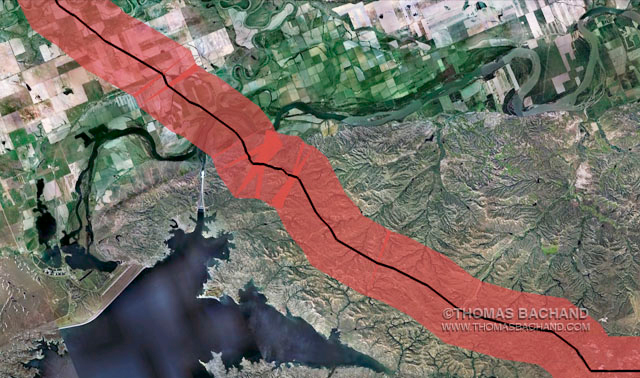
Thomas Bachand is creating Google Earth simulations of the evacuation zones around the Keystone XL route (image: Thomas Bachand)
CURWOOD: From the Jennifer and Ted Stanley Studios in Boston, this is Living on Earth. I’m Steve Curwood. More news now about the proposed Keystone XL pipeline. The US State Department, charged with delivering an Environmental Impact Statement about the pipeline, apparently does not know its exact geographical coordinates. This news comes through the work of Thomas Bachand, a California landscape photographer, who wanted to take pictures of the lands, creatures and people along Keystone XL. He pored through the State Department's original Environmental Assessment to see where he should go. That assessment was actually conducted by a private company, Cardno Entrix, and financed by TransCanada, the company planning the new pipe. But Bachand ran into a stone wall when he tried to figure out the exact route.
BACHAND: I was scouting the route for the pipeline for a potential photography project, and I needed a map, and I looked online for a map, and I discovered there was no map - that the only map was a rough map which is issued by TransCanada. And even if one needed to know the exact route, then such a map was not made public.
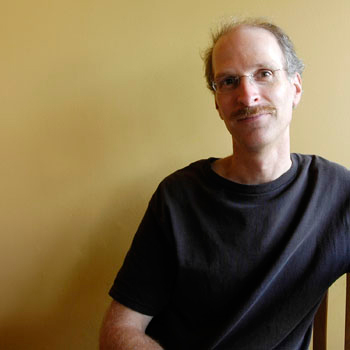
Thomas Bachand, photographer (photo: Kathryn Kowalewski)
CURWOOD: Now when you said you were working on a project, what kind of project did you have in mind?
BACHAND: Yes, I work on photo books. And I select a subject, and I go out there and I photograph it. So I was looking at the Keystone in that same regard. And when I looked at the map of it, I saw that it was just this ideal metaphor for land use and for energy policy, and for climate change in America. It just splits the country right in half. Literally, it goes right down the middle of the country. And it’s very controversial. And also, it seems emblematic of this struggle we have between resolving our use of fossil fuels with the environmental imperatives we’re now facing.
CURWOOD: So what happened when you tried to find out more information about the route of the Keystone XL pipeline?
BACHAND: Well, I started with...I looked at the final Environmental Impact Statement which is on the website for the Department of State, and I discovered there were engineering site maps for the route. But these site maps were missing longitude and latitude data. So unless you were physically on the site, you couldn’t really make sense of the pipeline route. So then I went to state agencies, and I was able to secure some of the information from the state agencies, and some of the landmark information.
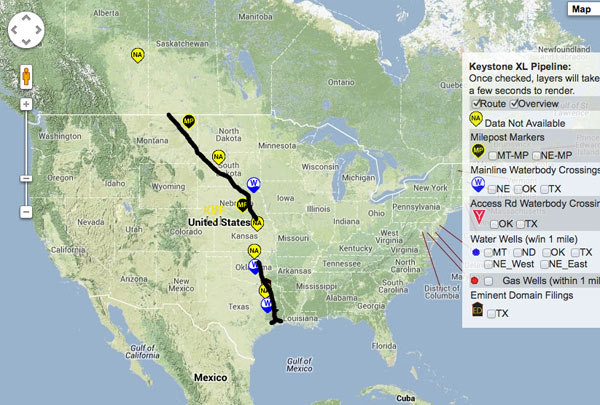
Thomas Bachand is trying to map the precise route of the Keystone XL pipeline (photo: Thomas Bachand)
CURWOOD: So you’re trying to find out about the route of the Keystone Pipeline, you look at the federal Environmental Impact Statement that the State Department has, and you don’t see any locators for this - there’s no way to really tell on the maps. Some of the states have some information, but not all. So I gather you ended up filing a Freedom of Information Act request with the State Department to find out exactly what those coordinates were. How did they respond?
BACHAND: Yes, I filed a Freedom of Information Act request when I hit a wall with the states. Some states would share the information, and some states wouldn’t share any information. And I would have to interpret where the route was, and I wanted to know exactly where it went. So I went to the State Department and I filed a Freedom of Information Act request. And I asked for expedited service, and I was denied. And I felt this was a very urgent situation because lots of people wanted to know where it goes, and they said it would take eight to 12 months.
CURWOOD: So describe the response you eventually got from the State Department for me.
BACHAND: Well then, you know I’ve been phoning them every few weeks to see what the status of my application is, and finally, I received a letter just last week, the week before, stating that they didn’t even have the information.
CURWOOD: Can you read a bit of that letter for me please?
BACHAND: Yes, hold on a second. Yes, probably a key sentence here. Let me see. ‘We were informed by employees familiar with the records and organization of those offices that the department does not have copies of records responsive to your request because the Environmental Impact Statement for Keystone Pipeline project was created by Cardno Entrix under a contract financed by TransCanada Keystone Pipeline LP, and not by the US government. Neither Cardno Entrix nor TransCanada ever submitted GIS information to the Department of State, nor was either corporation required to do so.’ So the Department of State didn’t require the information, and they never asked for the information.
CURWOOD: So, wait a second. You’re saying that State never asked and didn’t have the actual route of the pipeline, even though it was asked to approve the environmental impact on it.
BACHAND: Yes. Now I’m not familiar with what the protocol is at the State Department. But you would think that if they’re asked to approve the document, that the document would contain the actual route information.
CURWOOD: What does this say about the State Department’s ability to adequately assess the environmental impact of the project if they don’t actually know where the pipeline is supposed to go?
BACHAND: Well, you can’t. When you’re reading the final Environmental Impact Statement, you’re repeatedly referred to...they’ll be speaking about a certain landmark, whether it’s a wetland or a structure, and they’ll say ‘this item is 500 feet from mile-post marker X.’ And if you don’t know where mile-post marker X is, then you can’t make sense of the document. So this is a very fundamental problem. Now, I’m not an engineer, and like I said, maybe they have an engineering firm who reviews this for them, but as a member of the public, I think I should be able to read the document and interpret the document and make sense of the document. And I’m wondering if they have the ability to do the same, or do they completely wash their hands of it.
CURWOOD: So, Tom, how do you know feel about the whole thing? What kind of confidence do you have in our government?
BACHAND: I think the people working for the government are in large part, very well-meaning, and hard-working. I’ve spoken to many people at the Department of State, and they are the nicest people you could talk to - and they really believe in their work. But I do have this sense that the process has been captured by special interests, and that they get more of a say in what’s happening than the average citizen does.
CURWOOD: Thomas Bachand is a photographer and author based in Oakland, California. Thanks so much, Tom.
BACHAND: Thank you very much for having me.
Related links:
- Thomas Bachand’s website
- The Keystone Mapping Project, including the Dept. of State letter
[MUSIC: The Uplifters: “Inspired So” from Burning Bush”(The Uplifters Foundation / The Uplifters 2002)]
Coal and Shortened Lives in China

Air pollution has taken a toll on the health of Chinese residents. A person living in the north of the River Huai can expect to lives 5 years less than a person south of the river, an unintended legacy of the government’s policy to give free coal for winter heating in the north of the country. (US Embassy)
CURWOOD: Highly polluted air is bad for your health, and that's particularly true when it's air full of small particles from coal-fired power plants, as studies going back for years have shown. But just how bad? Now for the first time, there's a study that actually quantifies how many years of life expectancy are lost to a given amount of particulate exposure. Michael Greenstone is a Professor of Environmental Economics at MIT. He recently published a paper that compared two populations in China that experienced very different levels of polluted air.
GREENSTONE: The basis of the study comes from a Chinese policy that was implemented during the Planning Period.
CURWOOD: This was back in the 1980s we’re talking about.
GREENSTONE: It dates really from the 1950s to the 1980 period, although the legacy of the policy remains to date. But they didn’t have enough money to provide winter heating for everybody, so they somewhat arbitrarily decided that people who live north of the Huai River, which bisects the country into north and south, would have free winter heating, and that was provided through free coal and building the infrastructure to combust the coal to create heat. And the basis of the study is to compare people who live just north of the river with people who live just to the south of the river. And I should add, in the south, it was forbidden to build heating units.

The Huai River bisects China into North and South. (Wikipedia Commons)
So what the study did then is it got data from 1981 to 2000 on pollution, and what we find is pretty dramatic. Living north of the river led to almost 200 micrograms per cubic meter increase in total systemic particulates. Now, of course, most people aren’t familiar with those units, so to put it in context, it was about 350 micrograms per cubic meter in the south, and 550 micrograms per cubic meter in the north, and by comparison, the US average right now is probably 40 or 50. So both the levels are enormous, and the difference between the north and south is also enormous.
CURWOOD: So what did you find when you compared life expectancy for residents in the north versus the south?

Coal delivery in China. (bigstockimages.com)
GREENSTONE: It’s remarkable. So, as I mentioned, just at the river’s edge there’s a jump up in particulates concentrations, and that’s matched by a jump down in life expectancy. Specifically, what we found is people who live north of the Huai River, and were the intended beneficiaries of these policies, have life expectancy about five-and-a-half years less than people who live to the south.
CURWOOD: How many people live in that area to the north?
GREENSTONE: In north China there’s about 500 million people, and so, from that, we deduced that the policy is causing a loss of approximately 2.5 billion life years.
CURWOOD: What kind of illnesses? What kind of deaths were these people going through?
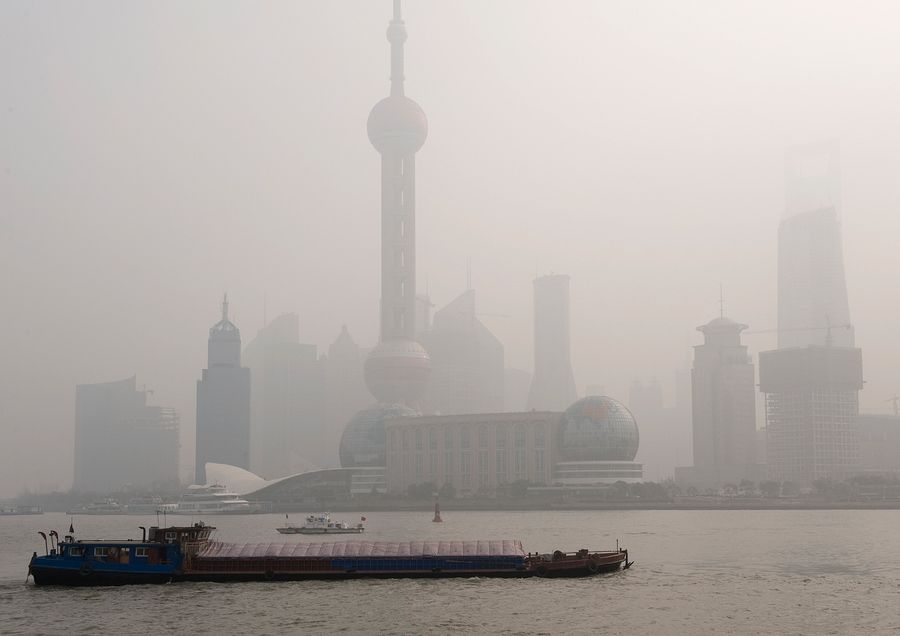
Air pollution over Shanghai (Bigstockimages.com)
GREENSTONE: All of the effects appear to be coming from elevated mortality rates due to cardiorespiratory causes of disease that are plausibly related to air pollution. So, lung cancer, heart attacks, other respiratory diseases. In contrast, we find no affect on mortality rates associated with causes of death that are non-cardiorespiratory.
CURWOOD: Where you able to break out just how much particulate would lead to just how much lower life expectancy?
GREENSTONE: Yes. So, in particular what we find is that an extra hundred micrograms per cubic meter of total suspended particulates is associated with a loss of life expectancy of about three years. And why that’s important is that that can be applied to other settings, both in other countries, and in other parts of China as well.
CURWOOD: Now the wind can carry air pollution from China across the Pacific Ocean to North America. Should people, say, in California be concerned about air pollution from China?
GREENSTONE: There’s always a concern about that, and it would definitely be the smaller particles that would be able to travel that far. I think probably the larger concern for Americans and really everyone who lives on the planet are the increasing rates of carbon dioxide emissions coming from China, which is a completely different pollutant, but is also associated with the combustion of coal and is causing climate change.
CURWOOD: So you don’t worry so much about particulates, you worry about CO2.
GREENSTONE: Yes. I mean, it’s worth emphasizing that China consumes more than half of the world’s coal.
CURWOOD: So what policies does China have now regarding this use of free heat in the north? And what are they doing to address the obvious public health problem?
GREENSTONE: Yes, so the legacy of the policy continues. It’s not quite in the same form. I don’t think the government is running around installing boilers anymore, but they continue to subsidize coal in the north. As an example, I’ve lectured at a university in Chengdu which is a city that’s in the south but it’s in the northern part of the south so they have cold winters. And it was just normal occurrence that when I was lecturing there was no heat in the building and all the students were wearing winter coats. So the legacy of this policy continues today. With respect to policy looking forward, I think what this study has helped to highlight is that consequences of air pollution in terms of human health are greater than what had been previously realized. And perhaps it will tilt the balance as they try to devise the optimal tradeoff between air pollution and increasing incomes.
CURWOOD: What has been the response to your study in China, privately as well as publicly?
GREENSTONE: Two of my co-authors are Chinese. One of them reported that on his microblog he had 300,000 hits in the first eight hours, and that was in response to a post describing the results. I think in the coming days and months, it will be very interesting to see what the impacts are, and the degree to which it affects Chinese policy. Candidly, China has an opportunity here to greatly improve the health of its citizens.
CURWOOD: Michael Greenstone is Professor of Environmental Economics at the Massachusetts Institute of Technology. Thanks so much, Professor Greenstone.
GREENSTONE: Thank you for having me.
Related links:
- Read the full China particulate study in the Proceedings of the National Academy of Sciences
- Abstract of the China particulate study
- About Prof. Michael Greenstone
[MUSIC: Asep Kosasih / Imas Permas: “Ceurik Rahwana” from The Rough Guide to the Music of Indonesia (World Music Network 2001)]
CURWOOD: Coming up, a forest from 50,000 years ago emerges underwater in the Gulf of Mexico. That's next on Living on Earth.
[CUTAWAY MUSIC: Joshua Redman: “Stop This Train” from Walking Shadows (Nonesuch Records 2013)]
Static Electricity: The Secret of Spider Webs
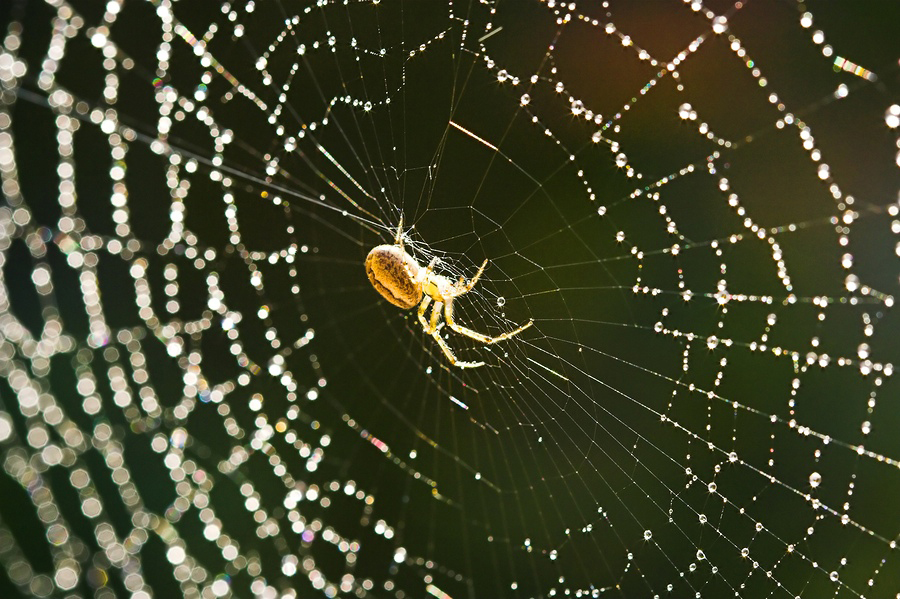
A cross spider, or garden spider, hangs in its web. (Photo: bigstockphoto.com)
CURWOOD: It’s Living on Earth; I’m Steve Curwood. In a minute, some distinctly unwanted bugs. But first this note on emerging bug science from Erin Weeks.
WEEKS: It’s a scene that plays out in summer gardens everywhere: a flying insect hums past, but fails to notice the gleaming strands of a spider web - until it’s too late. It’s glued to the silk, and soon a bulbous arachnid scuttles into view, and the unlucky insect becomes dinner.
A new study shows there’s more than luck at play here. A pair of researchers from the University of California at Berkeley have found that spider webs can actually reach out and grab prey.
Scientists have long known that vibrations caused by wind, the stickiness of silk, and even the architecture of webs can help a spider land a meal. Now they can add electrostatic charge to that list of helpers.

Spider webs can be attracted to the electrostatic charge of flying insects (Photo: Steve Ford)
The UC Berkeley team conducted an experiment that showed the electric charge insects generate as they fly can cause a spider web to bend toward the potential prey.
The scientists went out onto the Berkeley campus and collected a dozen garden spider webs. They also collected some insects: a handful of honeybees, bottle flies, fruit flies, and aphids.
Since the test insects were dead and couldn’t generate their own electrostatic energy, the researchers had to charge them artificially. They then dropped the charged bodies onto a web, filming the interaction between silk strands and insect.
Time and time again, they saw the web lean toward the insect.
It was only a tiny deformation, just a couple of millimeters. But in the insect world, mere millimeters can be the difference between life and death.
That’s this week’s note on Emerging Science. I’m Erin Weeks.
Related link:
Read more about the spider web study
Invasive Beetles and Moths On the March
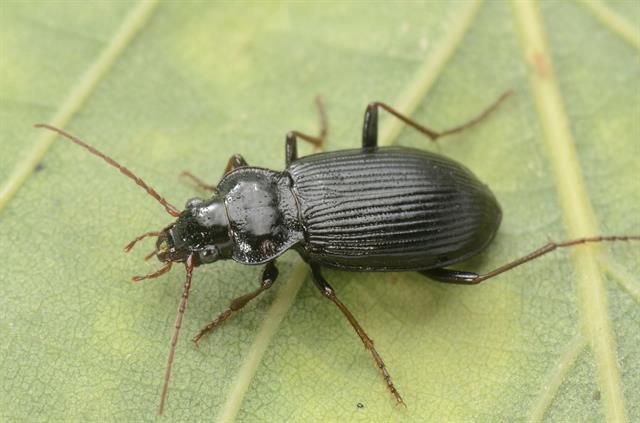
The European Gazelle Beetle (Encyclopedia of Life)
CURWOOD: Now many people find insects creepy and scary, with their many legs and waggling antennae, which is probably why they feature in some spectacular B horror movies. But some scientists find them totally fascinating, even though, as Ari Daniei Shapiro reports, there are good reasons to find some of them threatening.
[RUSTLING SOUNDS]
SHAPIRO: This is the sound of a dozen black beetles, each the size of my fingernail, scampering about in a plastic baggie. They came from a single fistful of Oregon soil. The person holding that bag is Jim Labonte, an entomologist with the Oregon Department of Agriculture.
LABONTE: The beetles that you hear are an exotic European species called Nebria brevicollis, the European gazelle beetle. And they were found just a few years ago in Oregon, and that was the first detection in North America. And they have become so abundant that we are concerned that they might be starting to compete with and exclude other native species.
SHAPIRO: That’s Labonte’s beat these days. He works with exotic species. Exotic because they’re from somewhere else. And it’s not just Nebria brevicollis that Labonte’s on the lookout for. In the past few years, he’s found one new foreign species every month, and those are just the ones he’s detected.
[LEAVES CRUNCHING OUTDOORS]
On this particular day, Labonte’s searching for bugs in traps in a lush vineyard in Hillsboro, Oregon, outside Portland. He’s crouched down close to the ground.
LABONTE: This is called a pitfall trap. It’s set in the ground, and it’s used for catching insects that will crawl over the ground.
SHAPIRO: Labonte holds up the clear cup and eyes its contents. A mix of native and exotic bugs speckle the green liquid at the bottom. The same goes for the other traps scattered about the vineyard; some local bugs, some foreign ones. Labonte doesn’t welcome the ones from some place else.
LABONTE: It’s a type of ecological pollution, if you will. They don’t belong there.
SHAPIRO: The real problems start when an exotic species becomes invasive, causing severe ecological and economic damage.
LABONTE: So, for instance, gypsy moth looove oak trees. So where you have heavy infestations of gypsy moth, oak trees tend to diminish after a while. And they’re replaced by other trees for instance, maple trees. Asian longhorn beetle...
SHAPIRO: That’s another kind of exotic invasive species...
LABONTE: ...loves maple trees. So if that gets well-established, you can pretty much kiss off maple trees. So when you lose one species, you don’t normally lose just one species. You lose the species that are dependent on it or associated with it.
SHAPIRO: Labonte’s wife, Diana Kimberling, agrees. She’s also an entomologist for the Oregon Department of Agriculture.
KIMBERLING: Last year we were dealing with eradicating gypsy moth here in Oregon. If it did become established, a lot of the native moths that are dependent on oaks could be outcompeted. So when those native species decline and you just have a single dominant exotic, it really does have this whole cascade of effects.
SHAPIRO: The real culprit here is global trade. Insects can burrow into packing crates, or stow away on cargo ships, and end up on a different coast, like in Oregon, where they can ravage native ecosystems.
LABONTE: So if we can detect them early, then it gives us the best chance for being able to either restrict their subsequent expansion of range or to maybe even eradicate them.
SHAPIRO: Labonte told me one story about a time he helped out with an eradication effort in Chicago of the Asian Longhorn beetle, scientific name Anoplophora glabripennis.
LABONTE: This is a species of beetle whose larvae bore in live trees. At that time, there was no recourse when you found an infested tree except you cut it down, burn it or chip it into pieces so small that no larva could survive inside of it. So I happened to go into this one yard, which had a magnificent maple tree: the canopy of the tree filled the entire backyard, and I found evidence of the Asian Longhorn beetle. And one of the most distressing things that I’ve had to do in my career was to tell the homeowner that this wonderful, beautiful tree was going to have to be destroyed. And she was clearly heartbroken, and understandably so - this tree had been part of her life. She had grown up in this house, but she understood the need to do this so that Chicago would not have such a widespread infestation of these that every tree of this type would be destroyed. And this demonstrates on a very small scale the impact of exotic invasive species.
SHAPIRO: For Living on Earth, I'm Ari Daniel Shapiro.
CURWOOD: Our story on invasive beetles is part of the series, One Species at a Time, produced by Atlantic Public Media, with support from the Encyclopedia of Life.
Related links:
-
- Encyclopedia of Life
[MUSIC: Kings of Convenience: “Riot on an Empty Street” from Misread (Astralworks 2004)]
Ancient Underwater Forest in the Gulf of Mexico
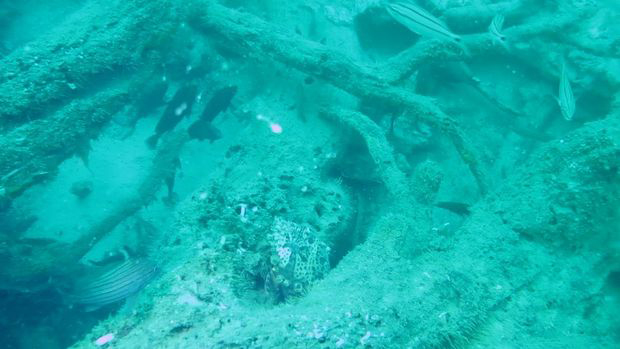
This cypress wood is over 50,000 years old (photo: Ben Raines/Alabama Press Register)
CURWOOD: And now let's head under the sea - not in search of mermaids, but of a long-lost forest. Deep beneath the surface of the Gulf of Mexico, off the Alabama coast, lie ancient cypress trees that only a handful of people have ever seen. One of those lucky few is Ben Raines, director of the Weeks Bay Foundation and he explained how it all came about.
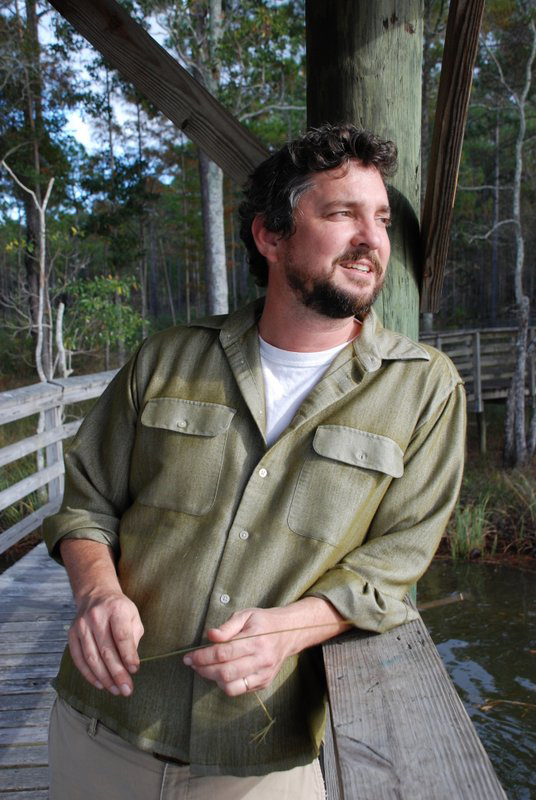
Ben Raines, director of the Week’s Bay Foundation (photo: Week’s Bay Foundation)
RAINES: For many years I was the environment reporter for the paper down here, The Press-Register, and so I had a buddy who owned a scuba diving shop, and he used to taunt me with this tale of an underwater forest that he had been diving on one time, and I pestered him for years and years and years, and he finally agreed to take me out there.
He heard about it from a fisherman who just noticed a ledge on his bottom machine as he was riding across the guif. So he started fishing there and started catching a lot of Red Snapper. And he gave the numbers, the GPS coordinates, to my buddy that owns the dive shop and asked him to go out there and see what it was. He hit the bottom and said there’s a bunch of trees.
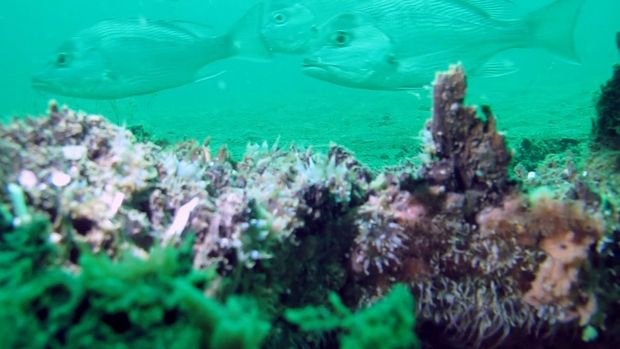
The trees have created new habitat for fish and other marine life (photo: Ben Raines/Alabama Press Register)
CURWOOD: Now how deep is deep for an underwater forest?
RAINES: Well, this is about 60 feet. Of course, all over the Earth, we know sea levels have gone down hundreds of feet. So we have a delta, a river delta here. Further up in the delta, about 80 miles inland, there’s sand dollars all over in these limestone bluffs. So we know sea level was that high at one time. Now we’ve got these trees 60 feet underwater, so sea level was that low, and it’s just a fascinating push and pull of the ocean through the climatic change over the eons.
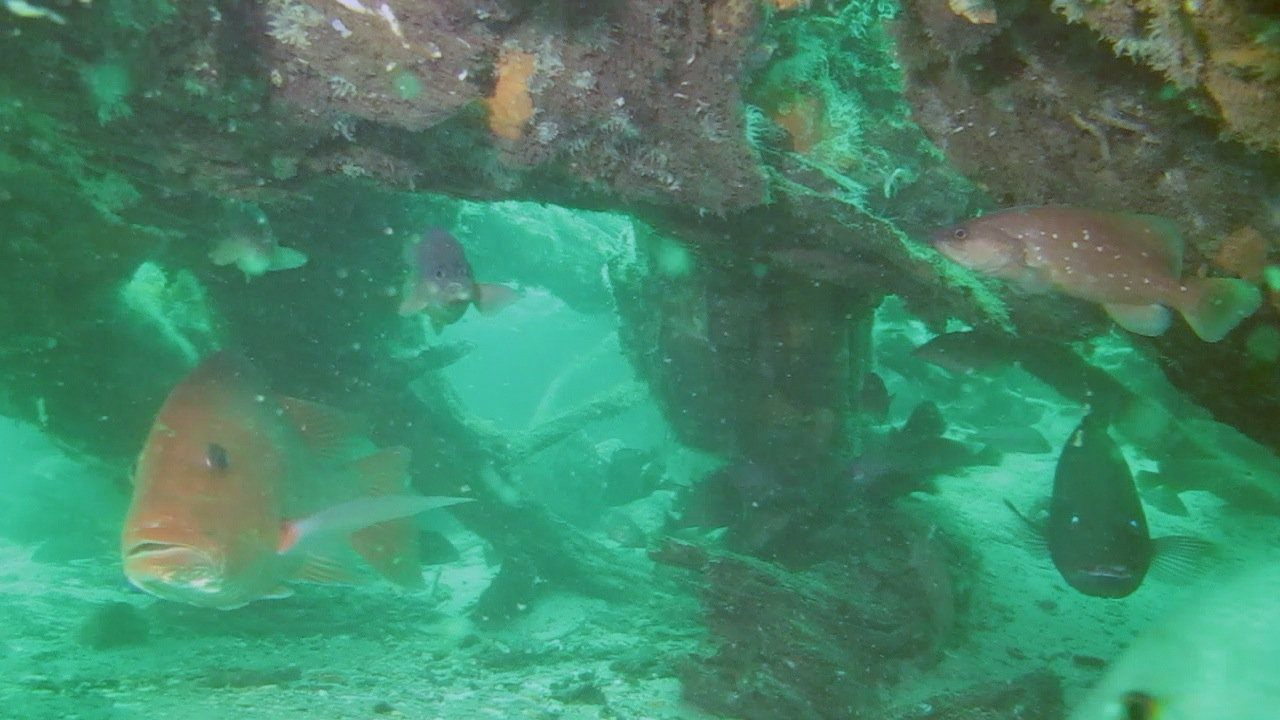
Fish hide in and among the roots of the trees (photo: Ben Raines/Alabama Press Register)
CURWOOD: So when did you finally get to visit the forest?
RAINES: I got out there a year ago last August. We went out...the first trip we tried to go out, the boat broke down. The second trip, the boat broke down.
CURWOOD: Of course. Boats always break down, don’t they?
RAINES: [LAUGHS] Absolutely. Especially my boats.
CURWOOD: [LAUGHS]
RAINES: So we finally made it out there and the way we dive here, we’ll drop the anchor over whatever the GPS number is. And then we swim down the anchor line to get to the spot because the water’s a little murky - otherwise you get lost. I went down the anchor line, and when I hit the bottom, there it was. The first stump. And it was about as big around as a garbage can lid, but it had that very distinctive irregular shape that a Cypress trunk has….
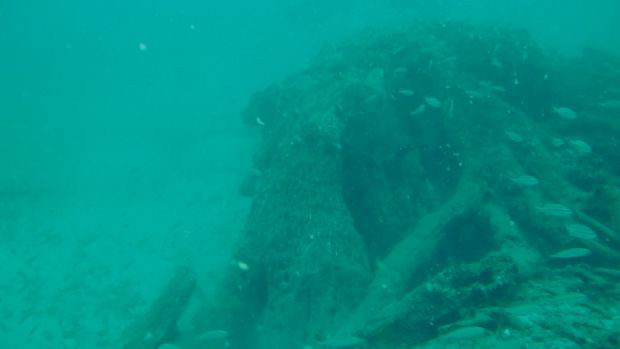
One of the many cypress stumps (photo: Ben Raines/Alabama Press Register)
CURWOOD: Uh-huh.
RAINES: …and then it was surrounded by knees. You know, Cypress trees have knees - you see them in the swamps - that stick up out of the water to kind of help hold them in place, and here was a Cypress tree on the bottom of the ocean. And I swam a few feet, and there was another one, and a few feet more, another one, and I quickly realized they were all around me in every direction.
CURWOOD: Wow. I mean, this sounds almost magical down there.
RAINES: It is absolutely magical. It’s totally enchanting. You know, these trees are covered in anemones and crabs and shrimp - and then you have these huge clouds of Red Snapper and Grouper following you around. I was down there one day swimming along the ledge where the biggest stumps are, and I turned around and there was this huge funnel shape of fish behind me, I mean it must have been 200 Snapper, and they were just following me around. When I stopped, they would stop. When I turned around, they all fell in behind me.
CURWOOD: [LAUGHS] What about the Groupers? They’re very social.
RAINES: Oh, yes. They’ll come right up to you. And some of the fish that are down there, the Trigger fish, will actually come up and chew on your camera. You have to shoo them away. They just seem to have no fear.
CURWOOD: You must have had a lot of fun because we saw this video that you made of your dive down there, and we’ll put it on our website. But have you experienced anything like that before?
RAINES: You know, I never had. I’ve been diving for some time, and from the moment I hit the bottom and saw the stumps, it was just exhilarating. You knew you were in this sort of “land of the lost”, this place that shouldn’t exist, but here it was, and I got the camera out, I hit the record button, and I never turned it off, and that’s exactly what I’ve done every dive I’ve made down there. And now I’ve been going down there with three cameras, you know, setting them up in different locations just to kind of capture this place while it’s there, because if we get a storm, it could theoretically come into the Gulf and change everything out there and bury this place up again. You know, it may be a very ephemeral place. We may only get to see it for a little while.
CURWOOD: So how old do scientists think these trees are?
RAINES: Well, I brought a few samples up, and I actually took a hand saw down there with me and cut them just like you’d cut a tree in your backyard. So I cut some sections out of them, gave them to Christine DeLong at LSU, and she had them radio carbon dated, and they had to do them three times in all I think because they didn’t believe the results. So they expected them to be 12,000 years old, which was the last ice age. Instead they came back radio carbon dead each time they tested them, which means they’re 50,000 years old or longer. So if we can...we want to get cores out of them, and then they’ll be able to count the rings and look at growth, and measure carbon inside them, things like that, and learn a lot about the past climate. We had another team come out from University of Southern Mississippi, and we had them do a sonar survey so we could try and get an extent of it because I’ve only been swimming around 300 yards of it. It turns out it’s spread close to a mile; it’s much larger than we thought, and there appear to be some much bigger stumps. I’m due to go over there next week again and see what we can - what we can ground truth some of those other locations, or sea floor truth them, I guess.
CURWOOD: Hey, Ben, how did this happen? I mean, how could these trees be preserved for so long?
RAINES: Well, any time in the ocean or anywhere else you’re able to get oxygen out of the mix, you stop decomposition. All those little bacteria and things that decay - cause decay - need oxygen, and so buried under six inches, eight inches of sand, you get into this anoxic layer where there’s no more oxygen. So these trees were covered up. We think Hurricane Katrina came through and dug this trench where the trees are now exposed, and so on the top layer of them, of the stumps, that top layer you can break it apart with your fingers - you know it’s very soft, and there’s all kinds of boring organisms digging holes in them. But once you get inside about a half-inch or an inch, then the wood’s very hard, and it’s like cutting a tree down - a living tree. And in fact, with the samples I brought up, when you cut them up in the dry air, you actually smell the smell of the sap just like you were cutting a fresh Cypress tree down. It’s really remarkable.
CURWOOD: Now that these trees have been uncovered, how will they survive?
RAINES: Well, they won’t. Ultimately, they’ll decay just like any wood that’s been sitting on the bottom of the gulf. The fact that they’re Cypress, gives them a little more longevity than other wood. Cypress is a very tough, rot-resistant wood, and for that reason, people love to make boats out of it. So, I don’t know how many years they’ll last. I can tell they’re decaying. I’ve been visiting it now for a year. And so I’ve got all these groups and companies calling me wanting to mine the logs. There’s a phenomenon called “sinker logs” where old Cypress trees that were actually so dense they couldn’t float would sink to the bottom of rivers, and there are companies now that go around and salvage these things, and they’re worth quite a lot of money. So here we’ve got the ultimate sinker logs, you know, 50,000 year old wood. So my goal is to have the place preserved before the numbers get out - the GPS numbers - so that people can go dive there, but I want it protected so they can’t go carve up the logs. I don’t want Fender and Gibson to get ahold of them and start making 50,000 year old guitars or 50,000 year old coffee tables. I’d like to see this preserved and in this enchanted little environment where people can enjoy it.
CURWOOD: So the place is still secret, those GPS numbers ain’t to be found publically, huh?
RAINES: That’s right. The place is still secret. There are very few of us who know where it is, and so far, everybody’s kept their mouths shut.
CURWOOD: Ben, it’s really clear you care about these ecosystems, and I understand you’ve been working hard on how the BP oil spill settlement money is going to be spent. Could you explain for us where we’re at in terms of that money?
RAINES: Sure. What we’re looking at right now - we’re expecting billions of dollars to come to the Gulf Coast from the Clean Water Act fines, and it’s coming through this mechanism passed by Congress called the Restore Act. This is an incredible windfall for the Gulf Coast where we seldom spend money on environmental projects of any kind. The states, environmentalists, politicians, are all lining up with pet projects they want to do.
For instance, Mississippi is looking to build a baseball stadium, Alabama is talking about building a convention center and a state park down at the beach. Nobody is talking about buying up and protecting coastal lands - at least not the way I think they ought to be. In Alaska, after the Exxon Valdez, 55 percent of the money that came from the Exxon settlement was spent buying coastal lands. We need to do the same thing down here.
So I’m advocating a nickel for the marshes - at least a nickel of every dollar of the BP money is spent buying coastal lands, because our marshes are the reason we survived the BP oil spill. They’re the reason we rebounded so quickly. Louisiana’s marshes were really just trashed, wiped out...they’re still so oily, bugs can’t live in them. Our marshes - that didn’t happen in Alabama or Mississippi or Texas or Florida - our marshes are still intact. So by preserving them we give the gulf a fighting chance - so the next time oil comes ashore somewhere - to rebound.
CURWOOD: So there you are, talking about this question with folks. What do you say is so important about protecting the gulf wetlands, you know, locking it up away from development?
RAINES: Well, the Gulf of Mexico has already lost about 50 percent of its marshland, and a lot of that’s in Louisiana, but Alabama has lost about 50 percent of its marshland. Mississippi, they built a 60-mile long man-made beach that replaced what used to be one of the longest stretches of coastal marsh in the United States. The marsh is the nursery for the Gulf of Mexico. You lose the marsh, you lose the habitat for all the shrimp, all the crab, almost everything that swims in the gulf uses these marshes at some point in its life cycle. If we don’t have marshes, we don’t have seafood, and the gulf produces about two-thirds to three-quarters of the United States’ seafood. It’s this incredible ecosystem, and it’s time now after years of beating up on it that we do something different and try to protect it.
CURWOOD: Ben Raines is director of the Weeks Bay Foundation in Fairhope, Alabama. Thanks so much for joining us.
RAINES: Thanks for having me. I really enjoyed it.
CURWOOD: Do check out Ben Raines video at our website, LOE.org. It's extraordinary!
Related links:
- Check out a video of Ben’s dive in the cypress forest
- Read Ben’s original story on the underwater forest
- Read Ben’s op-ed in the NYT about cleaning up the gulf
- Website for the Week’s Bay Foundation
[MUSIC: Solas: “The Words that Remain” from The Vega Set (Shanachie Records 1998)]
CURWOOD: Coming up...we have the antidote to environmental anxiety. So stay tuned to Living on Earth.
ANNOUNCER: Funding for Living on Earth comes from the Grantham Foundation for the protection of the environment. Supporting strategic communications and collaboration in solving the world’s most pressing environmental problems. The Kendeda Fund, furthering the values that contribute to a healthy planet, and Gilman Ordway for coverage of conservation and environmental change. This is PRI, Public Radio International.
[CUTAWAY MUSIC: Gabor Szabo: “Breezin” from High Contrast (Blue Thumb Records 1974)]
BirdNote ®: The Big Thicket

Prothonotary Warbler (Laura Gooch)
CURWOOD: It's Living On Earth, I'm Steve Curwood.
[MUSIC: BIRDNOTE® THEME]
We're often lucky enough on our show to be able to marvel at some of the many wonderful gifts nature has to offer us - and that's the case with today's BirdNote®. Here's Mary McCann.
[WETLAND FOREST BAYOU SOUNDS]

Sunset in the Big Ticket (Barclay Nix)
MCCANN: Tucked away in Southeast Texas is one of the most remarkable enclaves of nature. Known as The Big Thicket, this natural region is home to ten different ecosystems ranging from cypress bayous and arid sandylands to palmetto thickets, pine forests, marshes, and grasslands.
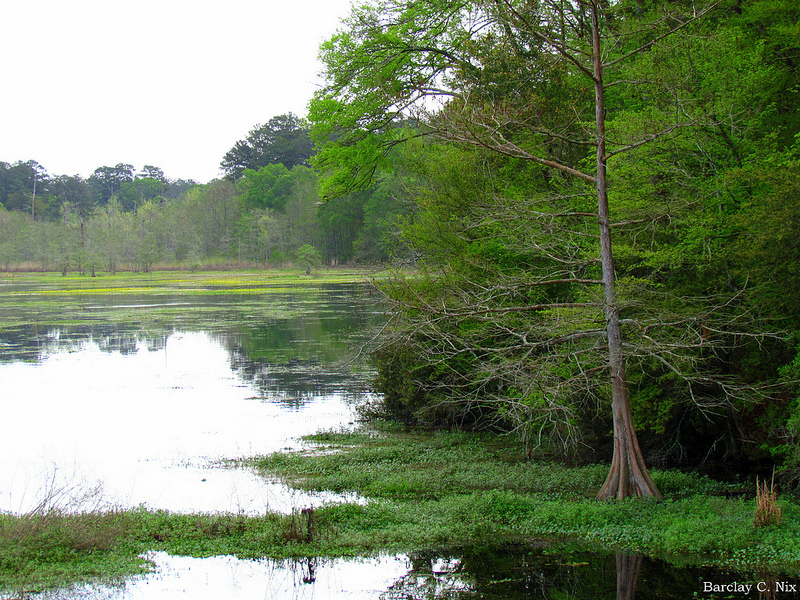
Neches River (Barclay Nix)
Such a wide variety of natural landscapes provides homes for a broad array of birds and other wildlife. More than 1,300 species of plants – including 30 wild orchids – have been tallied in The Big Thicket. Small wonder the region has been called “America’s Ark.” This spectacular diversity of plants is made possible by the dozens of soil types deposited by the outflow from melting glaciers at the end of the last Ice Age.
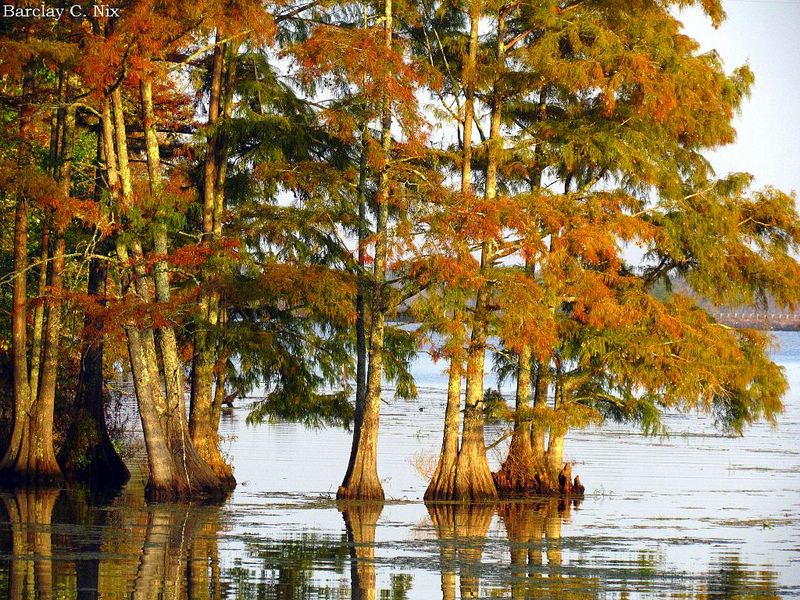
Cypress tree in Autumn (Barclay Nix)
Since the 1970s, the National Park Service has set aside nearly 100,000 acres (or about 3 percent) of this biogeographic region. Called the Big Thicket Natural Preserve, a valuable piece of this utterly unique natural world has been conserved.
Let’s listen again to “America’s Ark,” as Bullfrogs sing alongside Northern Cardinals and Prothonotary Warblers.
[BULLFROGS, NORTHERN CARDINAL, PROTHONOTARY WARBLERS]
I’m Mary McCann
CURWOOD: That soundscape was recorded by Gordon Hempton of QuietPlanet. To see some photos of the big thicket and its birds, hop on down to our website, LOE.org.
[1992.05.16b Wetland forest bayou day bird activity and 1992.05.18a 18A Wetland forest Bayou frogs and birds recorded by Gordon Hempton, of QuietPlanet.com
BirdNote’s theme music was composed and played by Nancy Rumbel and John Kessler.
Writer - Bob Sundstrom
Producer: John Kessler
Executive Producer: Chris Peterson
© 2013 Tune In to Nature.org July 2013 Narrator: Mary McCann
ID# bigthicket-01-2013-07-08 bigthicket-01
Re Man and Biosphere: http://www.unesco.org/new/en/natural-sciences/environment/ecological-sciences/man-and-biosphere-programme/
Background: Peacock, Howard. Nature Lover’s Guide to the Big Thicket. Texas A&M U. Press, 1994.]
Related link:
BirdNote®
[MUSIC: Beausolei: “Sounds of no” from La Danse de la Vie (Forward 1993)]
Saving Ourselves- The Green Boat

A Nebraska woman makes her thoughts known (photo: Kate Schneider/Bold Nebraska)
CURWOOD: Often as not, the news we report could hardly be classified as good news, and with so many stories about global climate disruption, species extinction, and habitat loss, it’s no wonder that many people may be feeling eco-anxiety these days. Well, Mary Pipher has an answer.
She is a psychologist and best-selling author of Reviving Ophelia, a groundbreaking book about adolescent girls, and her newest book is called The Green Boat: Reviving Ourselves in our Capsized Culture. It’s all about how we can have hope, save the earth and restore our mental health at the same time. She joins me now from a studio in her home state of Nebraska. Welcome to Living on Earth, Mary.

Mary Pipher (Photo: Rodale Press)
PIPHER: Thank you very much, Steve, it's really good to be on your show.
CURWOOD: Now you call the first chapter of your book, “Trauma”, and it’s all about the psychological impact of our current environmental crisis, so first explain, why is this traumatic?
PIPHER: Well, I think all of us could be called members of - let’s call it Generation One. No matter where we live, no matter who we are, we are the first generation in the history of the world to be faced with a planetary crisis which we must deal with rapidly and everywhere, and we all know this even when we claim we don’t know this.

The Green Boat (photo: Rodale Press)
For example, one of the books I found very helpful was a book by a guy named Stanley Cohen, called States of Denial, and he actually looked at what was happening in Nazi Germany during the genocide of the Jews. And what he found was, there was a phenomena that could be called willful ignorance - when something is going on that is too horrible to process, and yet too obvious to totally ignore, and that state of total ignorance, I think, is something that many of us feel - in fact all of us feel. It’s a matter of degree, but all of us go in and out of that state of willful ignorance around global climate change. When we truly think of it, we’re really talking about losing our Mother Earth, our planet, losing everything we love. Personally, that’s overwhelming news.

Nebraskan children demonstrate against the pipeline (photo: Marty Steinhausen/Bold Nebraska)
CURWOOD: In your book, you say, as a society, we’re basically in denial about climate disruption. In fact, we all know that some people don’t believe in it at all. But actually, you’re getting at something deeper than that. Can you explain?
PIPHER: I have in the book, a list of some of the kinds of things we do to block out awareness. We compartmentalize, we have times, all of us, when we want to eat some jumbo shrimp without thinking about the mango groves in Thailand, or we want to read our grandchildren or children a story about polar bears without thinking about the melting ice caps. So we all move in and out of kind of states of denial, and that’s totally understandable. In fact, it’s totally human, and it’s probably adaptive.
I never make the case that there’s something wrong with people for being in denial. I make the case it’s very understandable, and that we all are in denial some of the time, but what I do say is that unless we come out of that denial some of the time and face our situation squarely, we’ll be unable to solve it and deal with it. I have a quote I really like by James Baldwin: “Not everything that is faced can be changed, but nothing can be changed that is not faced.”
CURWOOD: So what can people do who in fact recognize that there is a problem, but feel paralyzed. What’s the best therapy here?
PIPHER: See, that’s probably the most important question you could ask because people get what I call “distractionable intelligence” which just makes them feel badly, and feel powerless, and I’m really a big fan of “actionable intelligence” that gives people an idea of what to do next. And the main thing I encourage people to do is become engaged with some kind of local work to help the planet. I say action is my antidote to despair.
CURWOOD: So, Mary Pipher, you prescribe action for yourself, and you found yourself helping to mobilize the Nebraska opposition to the Keystone XL Pipeline. How did you get going with this type of activism? Could you describe it for us please?
PIPHER: Well, thank you, Steve. It was a response action to my own despair. I found the best way I could heal myself, in a sense, from feeling miserable, which is not a state I like to be in, was to invite a few friends over and start talking about doing something. And in our state, the biggest, most urgent environmental issue was the Keystone XL Pipeline. So we started out with just two or three people, and we ended up building a statewide coalition of people who have, at least thus far, successfully fought and kept that pipeline out of our state.
CURWOOD: I was struck by your descriptions of the camaraderie you developed between a pretty diverse coalition in your state dealing with the Keystone XL Pipeline. How did that come together?
PIPHER: Well, first of all, one of the big things I believe about groups and action is the most important is it be really good in reinforcing to the members so they’ll keep doing it. So we always had potlucks, and we drank some wine, or we’d meet in parks, and we tried to plan a lot of fun actions because everybody’s real tired and busy, and they wouldn’t want to be involved with things that were just one more meeting in an office and dreary, and we’re always planning ahead and planning events, so we always had things going on that we were looking forward to.
But the biggest surprise for all of us with this group was - I live in Nebraska which is a very conservative state, and our biggest and first allies were conservative ranchers and farmers who really understood the water issues in our state. So we formed a new kind of alliance here in Nebraska between very conservative rural people and people like myself who are urban and progressive, and that was really something, Steve, to see that develop.
CURWOOD: By the way, I noticed you got Nigerians in your coalition in Nebraska, huh?
PIPHER: Yes, I met these Nigerians when I wrote a book called The Middle of Everywhere. And we had a whole lot of events one weekend at a festival, the viral festival, where events happened all over the state, but one of the events was Africans against the pipeline with our African refugee community. And some of the people who participated in that - the Ogoni people - had been people who were run out of Nigeria and many of their leaders killed because they had tried to stop a pipeline from coming down their river and in their area many years ago. And were driven out of Nigeria and ended up as refugees in Lincoln, and they came, and they very ardently spoke about how important it was to stop this pipeline. They said, ‘first we saw the plants die, then we saw the animals die, then we saw the people die.” It was a very dramatic event, and a fun event too, I might add, to have those cowboys and Africans together in the same park.
CURWOOD: You started this process pretty depressed by your own description. How are you doing now?
PIPHER: Well, bless your heart for asking. I’m about as happy as anybody else, is how I’d put it. Happy some days, not so much the other. But I’ll tell you, feeling you’re powerless is a self-fulfilling prophecy. If you think you’re powerless, you’re darn well going to be powerless. On the other hand, if you start acting as if you have power and influence, you engage in hopeful process, and you’re likely to find other people like that who will engage in that hopeful process with you. And those people start being close friends, and we’ve had a lot of fun and we’ve really grown to care about each other and, all in all, this experience of both riding the green boat and fighting the Keystone XL has been one of the more transformative experiences of my life, Steve.
CURWOOD: “Transcendence,” that’s what you labeled one of your chapters. Why is this so profound? Why do you think it had such a profound effect on you?
PIPHER: For me, the three transcendent responses are action, getting involved; increasing one’s own moral imagination, becoming kinder and more connected to other people and, in fact, other living beings; and then the third is finding more and more ways to be amazed and “blissed out” by the universe. Because if you’re doing the hard work that our group has done, that anyone does that looks honestly at the world, I think that needs to be balanced by lots of experience in which you’re just having a wonderful time, looking at the stars or sitting by water or enjoying your fresh grown tomatoes with your friends. So I think all three of those are really wonderful ways to move beyond despair and sorrow and into something bigger.
CURWOOD: At one point you write, and let me quote you here, “The necessary conditions for revival are not economic ones, but rather mindfulness and community.” Some might say that mindfulness and community can certainly help, but they might not be enough to solve a problem as serious as the climate crisis. What would you say?
PIPHER: But what is a better solution? You know what I think’s going to happen...first of all, nobody knows if we have solve these problems or not, and I’m not a Pollyanna. I don’t claim to know more than other people who’ve looked into things know, and nobody claims to know that’s being honest and knows what they’re talking about. We really have no idea what time it is in terms of the history of hominids and any other species - we have no idea what time it is. But what I do think, we’ll say this, if anything we’ll say this, it’s people all over the world waking up, realizing the situation they’re in, and realizing that they want to work together to build a sustainable future. And the interesting thing about that, Steve, is that is not some “pie in the sky” fantasy. I mean, that is happening all over the world. I can hardly get on my internet or get on the world wide web without news of some great new group that’s forming, or some new coalition of groups that’s forming somewhere on Earth to protect the planet. So I think it’s very likely that they’re will be a change in consciousness in the next few years when we need that consciousness to change. And that especially when we all know about each other and can connect and inspire each other, I think change can move very rapidly. Change has moved very rapidly in the history of the world as you know.
CURWOOD: Now, not everyone has the ability to get involved with a big political cause like the Keystone XL Pipeline fight as you got involved. So what advice do you have for people about maybe some littler things they can do in their lives.
PIPHER: First of all there’s always a cause nearby. Sadly, there’s enough issues and problems out there probably within ten blocks of your home you can find a good environmental cause to be involved with. One very simple thing I’m involved with now that’s virtually an issue everywhere is working with local power companies to encourage them to use a lot more sustainable and clean energy, but the main thing I tell people about getting involved is do what you love. Do what you have the skills to do and love to do and have a passion for it. Because, there’s so many causes, there’s so many issues, and all of the gifts of all of us will be required to make this work.
So if you have gift for art, if you have a gift for baking pies, if you have a gift for public speaking, or building. Whatever it is you have a gift for, that gift will be useful locally in some cause, and all you need, by the way, to be a group, is one other person. You and one of your friends on a front porch or sitting in your apartment can form a group, and the two of you can find some little action to begin with that’s going to make you feel like you’re a part of something larger than yourself and get you started on a path toward reclaiming power. And the other is make sure you’re savoring your life. Make sure you’re enjoying yourself and doing everything you can to look at the sky, look at the stars, walk beside water when you can, to be with positive people who are actively engaged and trying to have an impact on the world. Whether or not we can change the world, I guarantee you, Steve,that will change us.
CURWOOD: Mary Pipher is a psychologist and author of the new book The Green Boat. Thanks for joining us, Mary.
PIPHER: Thank you, Steve.
Related links:
- Check out Mary Pipher’s website
-
[MUSIC: Oliver Mtukudzi: “Ndagarwa Nhaka” from Greatest Hits: The Tuku Years (Sheer Sound 2003)]
CURWOOD: On the next Living on Earth, a chef with a surprising cuisine - bugs.
GORDON: You know, I really like waxworms - these are small caterpillars. When you actually roast them, they taste like pistachio nuts. It's like, what's not to like?
CURWOOD: A different take on animal protein and much more, next time on Living on Earth.
[SOUND OF WAVES]
CURWOOD: We leave you this week with the sound of waves lapping gently on a beach. The ocean's a potent inspiration for poets.
[SOUND OF WAVES]
CURWOOD: John Keats wrote, "It keeps eternal whisperings around desolate shores." And in Dover Beach, Matthew Arnold wrote that "the sea is calm tonight" but you can hear “its melancholy long withdrawing roar."
This seascape was recorded by Med Goodall for the Sounds of the Earth CD, The Sea.
Living on Earth is produced by the World Media Foundation. Naomi Arenberg, Bobby Bascomb, Emmett Fitzgerald, Helen Palmer, Poncie Rutsch, Erin Weeks, Adelaide Chen, James Curwood, Jennifer Marquis and Gabriela Romanow all help to make our show. We had engineering help this week from Noel Flatt. Jeff Turton is our technical director. Alison Lirish Dean composed our themes. You can find us anytime at LOE.org. And check out our Facebook page, it’s PRI’s Living on Earth. And we tweet from @LivingOnEarth. I'm Steve Curwood. Thanks for listening.
ANNOUNCER: Funding for Living on Earth comes from the Grantham Foundation for the Protection of the Environment, supporting strategic communication and collaboration in solving the world’s most pressing environmental problems. The Kendida Fund, furthering the values that contribute to a healthy planet. And Gilman Ordway for coverage of conservation and environmental change. Living on Earth is also supported by a friend of The Nation where you can read such environmental writers as Ren Stevenson, Bill McKibben, Mark Hertsgaard and others. At The Nation dot com. This is PRI, Public Radio International.
ANNOUNCER 2: PRI Public Radio International.
Living on Earth wants to hear from you!
Living on Earth
62 Calef Highway, Suite 212
Lee, NH 03861
Telephone: 617-287-4121
E-mail: comments@loe.org
Newsletter [Click here]
Donate to Living on Earth!
Living on Earth is an independent media program and relies entirely on contributions from listeners and institutions supporting public service. Please donate now to preserve an independent environmental voice.
NewsletterLiving on Earth offers a weekly delivery of the show's rundown to your mailbox. Sign up for our newsletter today!
 Sailors For The Sea: Be the change you want to sea.
Sailors For The Sea: Be the change you want to sea.
 The Grantham Foundation for the Protection of the Environment: Committed to protecting and improving the health of the global environment.
The Grantham Foundation for the Protection of the Environment: Committed to protecting and improving the health of the global environment.
 Contribute to Living on Earth and receive, as our gift to you, an archival print of one of Mark Seth Lender's extraordinary wildlife photographs. Follow the link to see Mark's current collection of photographs.
Contribute to Living on Earth and receive, as our gift to you, an archival print of one of Mark Seth Lender's extraordinary wildlife photographs. Follow the link to see Mark's current collection of photographs.
 Buy a signed copy of Mark Seth Lender's book Smeagull the Seagull & support Living on Earth
Buy a signed copy of Mark Seth Lender's book Smeagull the Seagull & support Living on Earth

